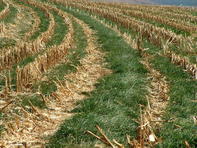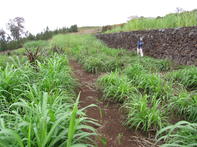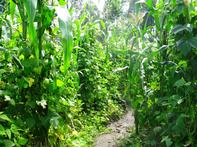Where pastures are already established, a farmer may decide to renovate a pasture by overseeding or just managing the existing pasture. If the pasture has 40 - 75% of a crop present, a new pasture might be planted by overseeding into the existing pasture, but if less than 40% of a pasture remains, it might be best to reestablish the pasture.

When preparing to plant pastures, both the landscape position and the soil type of the site play an important role in determining the choice of pasture crop. It will also determine the best planting technique. Always use fresh, high-quality seed and before planting legumes, make sure to inoculate the seeds with the correct strain of Rhizobium bacteria to allow for proper nitrogen fixation in the soil. Ask your seed supplier for advice on site and seed selection.
Site Selection for Pasture Planting

The potential yield of pasture will be influenced by the soil’s characteristics and fertility. For example, the subsoil of the site may prevent deep infiltration of water, causing the topsoil to become waterlogged. Moisture-loving pasture grasses like Napier and bana grass might be good choices.
The steepness of the land will influence water runoff and soil erosion which might necessitate measures such as contours and terracing. To slow down the rate of water flow downhill, creeping and sod-forming grasses can be planted in broad strips. This will also increase water infiltration into the soil.
Planning Pastures
Start preparing the soil 6 - 12 months before the actual planting date. Before planting any crop, it is important to have a soil test done to determine nutrient deficiencies and pH of the soil. This soil test will also determine which pasture crops are most suitable for your soil type.
Thereafter, nutrients can be added to the soil as well as organic matter to stimulate microbial life in the soil. Incorporate the necessary adjustments, fertilisers and nutrients during seedbed preparation or when sowing.
Seedbed Preparation
The seeds of most grasses and legumes are very small and it is, therefore, necessary for the seedbed to be even, weed-free and firm. Seeds need moisture to germinate and develop roots so good seed-to-soil contact is essential to ensure adequate moisture near the seeds. Seedbed preparation depends on the type of equipment available. If a new pasture is being established, conventional tillage may be used but if an existing pasture is being renovated, the no-till drill method may be better.
Planting can be done with conventional or no-till methods. In conventional planting methods, the seedbed is ploughed and disked to prepare the seedbed and in no-till methods, seeds are planted without mechanically disturbing the soil. Conventional planting should be used when a uniform seedbed is needed. It breaks up large soil clods and some farmers reckon it warms up soil faster and helps establish a more uniform pasture. However, conventional tillage may change soil structure and cause soil erosion.
No-tillage involves seeding directly into the residue pastures. Residue must first be reduced by hard grazing or hay removal. No-till methods reduce soil erosion and conserve moisture but seedlings might germinate more slowly and less uniformly.
Best Planting Time
When planting pastures, the sowing date is very important. Obviously, the choice of pastures - summer-growing or winter-growing will determine your sowing time. Ideally, a farmer needs to have pasture available at times of food scarcity or droughts. Planning the planting time will also determine when a pasture will be harvested.
Keep in mind that pastures will not only be grazed but can also be harvested and stored in the form of silage or hay. Weeds might determine the planting season, for example, planting of pastures in spring and early summer can limit the growth of winter weeds.
Planting Techniques

Pasture seeds are usually broadcasted but sometimes sowing pastures in rows is preferable. In this case, an ordinary seed drill can also be used to plant it in rows, for example where pastures are to be established in wide rows between cash crops. It is important to plant seeds at the right depth to allow for optimum germination.
Planting can be done by hand or with a hand-operated seeding machine. A wheat planter from which, the teeth/knives have been removed can also be used. In this way, seeds will fall onto the soil surface and no deeper. Alternatively, a fine seed planter used for vegetable production can be used. Seed can also be mixed with phosphate or lime and sown with a lime spreader.
Direct drilling may be used. For example, it is possible to add ryegrass and clover to an existing legume-dominated pasture by direct-drilling or planting in the mulch of a previous crop. This is done to thicken up the pasture or to add grass to legume-dominated pasture. The technique will not work with cock’s foot, fescue or lucerne.
By Marinda Louw